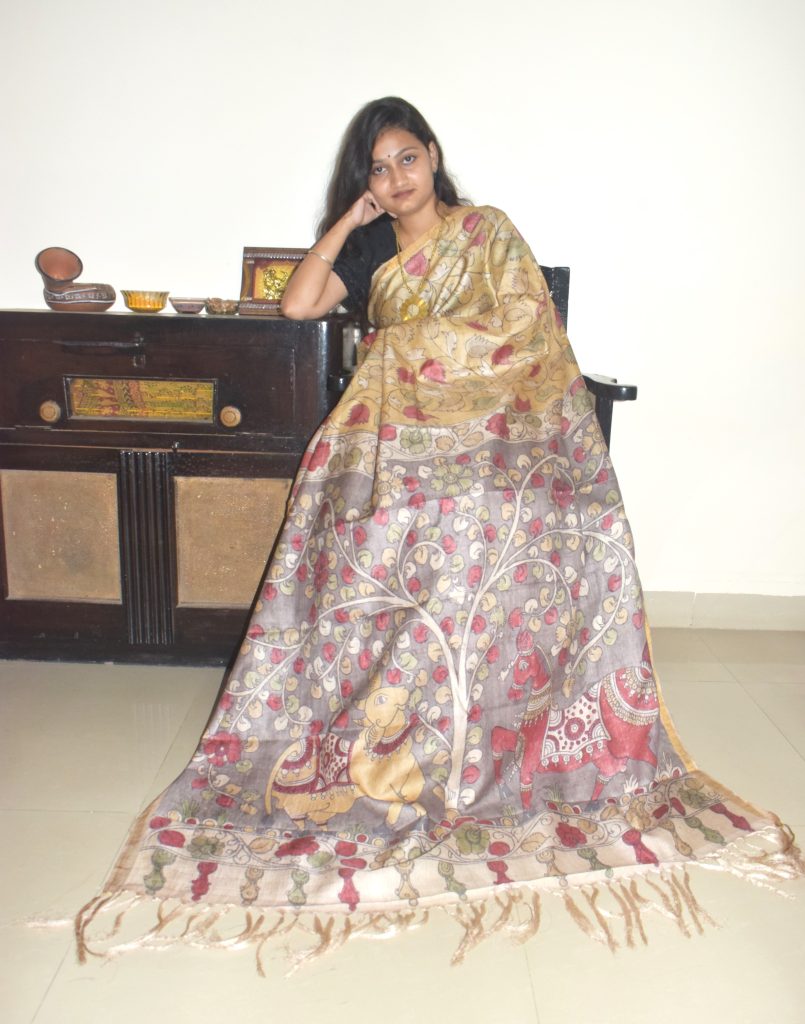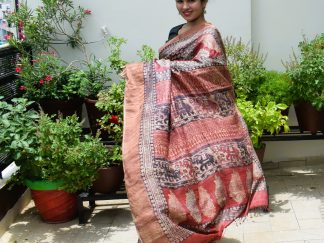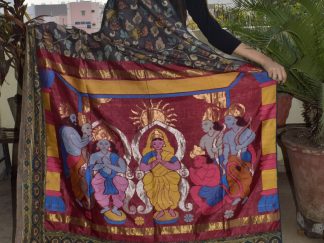Description
History
Vrathapani now known as Kalamkari is more than 3000 years old ancient craft practiced as temple art in southern part of India. Today it is known as Kalamkari due to influence of Persian rule in 15th century. Locally this solution known as “Kasim”. Vrathapani meaning in Telugu is writing on cloth. It is also meaning story telling on cloth.
Practitioners of this art which comprises a group of wanderers including painters, musicians and other artists, who describe mainly the historical events from “Ramayan” or “Mahabharat” and other ancient historical texts by narrating stories and at the same time drawing it on cloth to have both oral description and visualization of the art.
During 1960s when temples were acquired by Governments temple priests who were patrons of this art stopped buying Vrathapani from the artists. Then Late Smt. Kamla Devi Chattpadhay came as rescuer to this art. She encouraged artists to start developing new products and then temple craft becomes wearable art.
Original process of Vrathapani comprises multiple steps and processes and natural dyes were used in the process which requires 20 days minimum. Today there are lot of changes happens due to market demand, unavailability of raw materials and influence of synthetic chemical dyes.
Process
A fabric is scoured extensively to remove starch and impurities then it is soaked in a paste of buffalo milk & myrobalan for 2 hours then put in dry under the Sun. After fabric is dried then a pen (Tulika in Sanskrit & kalam in Persian) is used to draw outline using natural mordant (color binder) made from iron rust mixed with jaggery. After outlining is done it is again put it in a dry place for a day or two. Then wherever red color required it is painted with a brush (Traditional brush made from bamboo stick layered with threads by putting foam or cotton inside. Red color in past extracted from chavalkodi (Indian madder) roots now replaced with synthetic alizarin mixed with alum water applied. Now after drying the fabric it is again washed in running water and then dye in boiling water with jaji leaves and little alizarin put into it for darker shade. Now fabric is again dried under sun. Now we got black outline and red color, now fabric is again put in buffalo milk for an hour. It is again dried under sun. Now fabric is ready for different color combination except red on different places required or demanded by customers. After applying colors it is again put it in a dry place for 2 to 3 days. Now fabric is again washed in running water. After drying it is ready to use.
Colors & its Source
| Color | Source | Natural/Synthetic | |
| Pink | Indian madder | Natural | |
| Grey | Alum + myrobalan | Natural | |
| Black | Iron rust + myrobalan | Natural | |
| Yellow | Pomegranate peel, Myrobalan flower, Turmeric | Natural | |
| Green | Pomegranate + Synthetic blue | Semi natural | |
| Blue | Lakshmi blue | Synthetic | |
| Red | Alizarin | Synthetic |
| Brown | Catechu | Natural |





Reviews
There are no reviews yet.